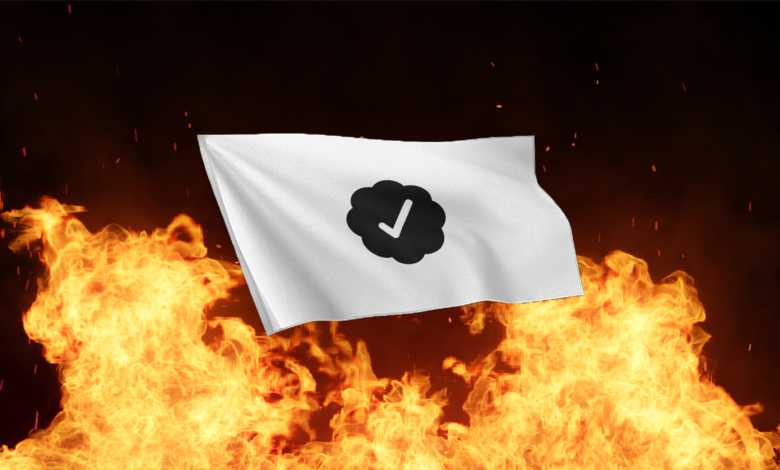Jack Butcher’s Checks Are Burning. What’s Next?

When Jack Butcher introduced his Checks project to the NFT space, he did so with a single sentence: “This artwork may or may not be notable.” Since his initial Tweet, it’s become clear that not only are Checks notable, but the collection marks a major shift in NFTs for the first time in nearly a year.
Although still convoluted to some, Checks has emerged as the frontrunner of the newly incepted open edition (OE) craze, as well as a timely commentary on and criticism of Twitter verification under Elon Musk’s ownership of the platform. As the project continues to take on a life of its own — inspiring community, conversations around social status, and countless derivatives — the unique endeavor has entered into its second phase, taking the NFT space for a ride yet again.
Checks’ unique burn mechanism
On February 12, after weeks of anticipation and the introduction of Checks migration, Butcher initiated phase two of the project by introducing a burn mechanism. A common feature among OEs, burning refers to the destruction of an NFT or multiple NFTs through which either a new token is created or a different incentive or reward is yielded by the user whose token was burnt.
Burn dynamics often create conflict among those who find it difficult to decide between burning or safekeeping their NFTs. But considering the Checks collection originally totaled over 16,000 pieces, it seemed holders were more than happy to enter phase two once open. Furthermore, a significant amount of fanfare came from the fact that, upon burning a Checks NFT, users would receive a unique on-chain piece of artwork in return.
It all begins with holders of multiple Checks editions. Butcher himself theorized that, given the total supply of NFTs vs. the number of unique owners, most collectors would likely hold around six NFTs, with 80 Checks per NFT. From there, he settled on a system that would allow the burning of two original, 80-check pieces to create an NFT featuring 40 checks. Then, by burning two 40s, users could create a 20-check piece, and so on, down the line, hitting the lowest potential numbers of 10, five, and four checks per NFT and ultimately culminating in a single colored check. But it doesn’t stop there, as Butcher outlined in a massive Twitter thread leading up to the burn.
As only 250 single checks could possibly exist (thanks to Butcher for doing the math), given the number of holders in the collection, Butcher added incentives that went beyond the initial burn. If a holder can acquire and burn 64 single check pieces, they can produce a new, single black check artwork, of which only three can ever possibly exist. While some deep-pocketed collectors out there may endeavor to follow the rabbit hole all the way down, doing so would likely only serve to increase the scarcity of the original 80-check pieces.
Further, Butcher aims to ensure holders retain a significant amount of agency throughout phase two by allowing burn participants to dictate their NFT’s token ID and color palette. When burning two pieces, users get to choose which of the two token IDs to preserve and transfer to the new on-chain NFT created as a result. Similarly, because the color of this new NFT is affected by the tokens burned to achieve it, holders are incentivized to strategize, according to their visual preference, which pieces to collect and burn to combine.
Burning Checks, what’s next?
In the NFT space, imitation often goes far beyond flattery, often resulting in a slew of low-quality copycat endeavors. We’ve seen it happen time and time again following the popularizing of CryptoPunks, Bored Apes, Loot, Azuki, Goblintown… the list goes on. But oddly, although some cash-grabby derivatives did surface, knockoff Checks have mostly been the product of prominent builders in Web3 and have subsequently been hailed as successes themselves.
Perhaps this is due to the significance of the underlying themes that Butcher has instilled in his project, which focus on the criticisms surrounding social media verification. Or maybe it has more to do with the respect that Butcher and his brand Visualize Value have accrued over the past few years. Whatever the reason, it’s hard to see the success of Checks, the subsequent OE boom, and the corresponding rise in NFT sales throughout 2023 Q1 as existing independent of Butcher.
Given the lasting awe surrounding Checks, it’s hard to say when its popularity might die down. Adding in the fact that Butcher seems to honor a policy of building in public — with his lengthy, dense Twitter threads chronicling every project development providing testament to this — it’s possible he will maintain his hold on the NFT market for months to come. And this might not prove to be a bad thing, considering that concurrent with his highly publicized collections, Butcher has also launched philanthropic NFT endeavors piggybacking off of the success of Checks.
If there is to be one major takeaway from all that has transpired with Checks during its first month of existence, perhaps it’s that user engagement matters most. From keeping collectors appraised of goings-on, encouraging community building, and promoting collector agency as a means for forward development, whether or not his complex mechanics result in collector feats on a grand scale, Butcher’s teachings will surely be implemented down the line and have undoubtedly earned a seal of approval from Web3.





